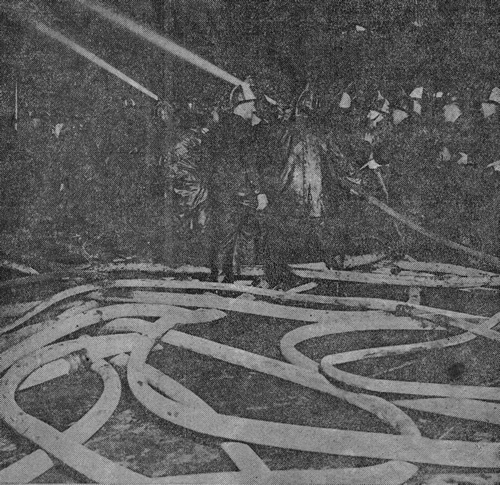|
FIRE IN POST ST. INJURES CHIEF CONLON
ASSISTANT HEAD OF DEPARTMENT MAY DIE FROM ASPHYXIATION
MANY FIREMEN ARE OVERCOME
DOWNTOWN BLAZE TAXES FULL POWER OF HIGH PRESSURE SYSTEM
$100,000 PROPERTY LOSS
John J. Conlon 1st Assistant Chief, was killed in the discharge of his duty as the result of asphyxiation during a fire on Post street Saturday night
Assistant Fire Chief John J. Conlon is near to death from asphyxiation suffered last night while fighting a stubborn fire in the three-story building at 215-225 Post street, occupied by E. B. Rice, millinery and furs, Radke & Company, jewelers, and the Tea Cup lunch room.
Many other firemen were overcome by the dense smoke, including Battalion Chief Thomas Murphy.
Property damage estimated at $100,000 was caused by the flames, which for two hours baffled the best efforts of Fire Chief Thomas R. Murphy and his men.
The firemen most seriously injured and taken to the Emergency Hospital were:
Conlon, John J., First Assistant Fire Chief; may die from smoke asphyxiation.
Murphy, Thomas Battalion Chief; smoke asphyxiation.
Morrison, William, truckman; burns and smoke asphyxiation.
Oakes, Oscar A., stoker; smoke asphyxiation.
Evans, Earl, hoseman; smoke asphyxiation.
Klatt, Joseph F., stoker; smoke asphyxiation.
DIFFICULT TO FIGHT.
Extreme difficulty was experienced by the firemen in reaching the portion of the building where the fire was raging, and before they could do effective work the fire had eaten its way through from the basement, where it originated, to the second and third floors.
Just before the firemen gained the upper hand, the flames burst through the roof and, for a few minutes there was danger that the fire would leap into the tall head building adjoining.
Thousands of people witnessed the spectacular battle between the firemen and the fire, and there were thrills aplenty as fireman after fireman was dragged out of the sidewalk elevator shaft, helpless and gasping from having inhaled the choking smoke.
Later, when the firemen raised ladders to the second floor and entered with their lines of hose, several more firemen were carried down the ladders after having been overcome by the smoke that was as dense on the upper floors as it was below.
CONLON FALLS IN BUILDING
Assistant Fire Chief Conlon was far inside the building with his men when he fell limp on the floor. In the darkness and blinding smoke the firemen lifted Chief Conlon and stumbled back with him to the street, where it was seen that he was unconscious.
Sometime later, in the same portion of the burning building. Battalion Chief Murphy collapsed, and his men lifted him to their shoulders and backed out to where an sidewalk space, and there was an ambulance was waiting to hurry him away to the Emergency Hospital.
Though near to the verge of unconsciousness, Chief Murphy gave a command to his men as he was carried away, and they rushed back into the building and resumed their dangerous work.
FURS TOTAL LOSS.
The E. B. Rice stock of millinery and furs, valued at about $30,000, total loss, as was also the equipment and fixtures of the Tea Cup, which occupied the third floor of the building. Radke & Co., jewelers, valued their stock and fixtures at about $150,000, they suffered contained goods of various kinds, and severe loss from smoke and water.
There appeared to be much uncertainty as to how the fire originated. The whole basement of the building contained goods of various kinds, and many empty packing cases; and in the sub-sidewalk space occupied by E. B. Rice there was a gas stove which was used by the women employed by Rice. Whether this stove had been left burning, or whether the fire originated in the main basement, as seemed likely from the later progress of the fire, was not determined.
When the firemen arrived the smoke was rolling out from the sub-sidewalk space, and there was no evidence that there was fire in the other portion of the building; but after the sub-sidewalk space had been deluged with water for nearly an hour the smoke continued to roll out in dense clouds, and without warning the flames burst through to the second floor fifty feet back of the sidewalk line. The firemen then had an open fight: they could see the fire, and it was not long before they had conquered it.
Source: San Francisco Examiner, 1919 March 2

Photo
30 LINES OF HOSE FORM WATER BARRAGE
The fire protective resources of the downtown section were brought into full play last night at a fire in Post street, between Stockton and Grant avenue. Six lines of hose were attached to each high pressure hydrant and engines pumped water into monitors. Thirty lines of hose were playing at one time.
JEWELER HELD AS “AD” FRAUD
1919 March 3
A warrant was issued yesterday for the arrest of Richard Radke, of jewelry firm at 219 Post street, on a charge of falsely advertising goods for sale.
Recently Radke’s place was burned out. It was there that Battalion Chief “Buck” Conlon lost his life.
A fire sale has been carried on in the place.
H. J. McMahon, deputy sealer of weights and measures, charges Radke with having falsely advertised goods on sale there.
According to McMahon and Elliott Epsteen, attorney for the San Francisco Ad Club, Radke has been selling jewelry of an inferior nature, bought since the fire, under a claim that it was damaged goods.
Warrants also were issued against Robert Jacobson and Abraham Krugman, auctioneers in the place, for the same offense
Source: San Francisco Examiner, 1919 March 4
Extracted from original sources with grammar and spelling as published.
|



